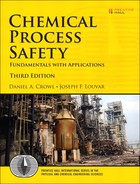Preface
The third edition of Chemical Process Safety is designed to enhance the process of teaching and applying the fundamentals of chemical process safety. It is appropriate for an industrial reference, a senior-level undergraduate course, or a graduate course in chemical process safety. It can be used by anyone interested in improving chemical process safety, including chemical and mechanical engineers and chemists. More material is presented than can be accommodated in a three-credit course, providing instructors with the opportunity to emphasize their topics of interest.
The primary objective of this textbook is to present the important technical fundamentals of chemical process safety. The emphasis on the fundamentals will help the student and practicing scientist to understand the concepts and apply them accordingly. This application requires a significant quantity of fundamental knowledge and technology.
The third edition has been rewritten to include new process safety technology, new references, and updated data that have appeared since the first edition was published in 1990 and the second edition in 2002. It also includes our combined experiences of teaching process safety in both industry and academia during the past 20 years.
The third edition contains two new chapters. Chapter 8, “Chemical Reactivity,” was added due to the recommendations from the US Chemical Safety Board (CSB) as a result of the T2 Laboratories accident investigation. Chapter 13, “Safety Procedures and Designs,” was added to consolidate some material that was scattered throughout the previous editions and to present a more complete and detailed discussion. We removed the chapter on accident investigations that appeared in the first and second editions; much of the content was moved to Chapter 13.
We continue to believe that a textbook on safety is possible only with both industrial and academic inputs. The industrial input ensures that the material is industrially relevant. The academic input ensures that the material is presented on a fundamental basis to help professors and students understand the concepts. Although the authors are (now) both from universities, one has over 30 years of relevant experience in industry (J.F.L.), and the other (D.A.C.) has accumulated significant industrial and government consulting experience since the writing of the first edition.
Since the first edition was published, many universities have developed courses or course content in chemical process safety. This new emphasis on process safety is the result of the positive influences from industry and the Accreditation Board for Engineering and Technology (ABET). Based on faculty feedback, this textbook is an excellent application of the fundamental topics that are taught in the first three years of undergraduate education.
Although professors normally have little background in chemical process safety, they have found that the concepts in this text and the accompanying problems and solutions are easy to learn and teach. Professors have also found that industrial employees are enthusiastic and willing to give specific lectures on safety to enhance their courses.
This textbook is designed for a dedicated course in chemical process safety. However, we continue to believe that chemical process safety should be part of every undergraduate and graduate course in chemistry and chemical and mechanical engineering, just as it is a part of all the industrial experiences. This text is an excellent reference for these courses. This textbook can also be used as a reference for a design course.
Some will remark that our presentation is not complete or that some details are missing. The purpose of this book, however, is not to be complete but to provide a starting point for those who wish to learn about this important area. This book, for example, has a companion text titled Health and Environmental Risk Analysis that extends the topics relevant to risk analysis.
We are indebted to our many friends who helped us learn the fundamentals of chemical process safety and its application. Several of these friends have passed on—including G. Boicourt, J. Wehman, and W. Howard. We especially wish to thank S. Grossel, industrial consultant; B. Powers, retired from Dow Chemical Company; D. Hendershot, retired from Rohm and Haas; R. Welker, retired from the University of Arkansas; R.Willey of Northeastern University; R. Darby, retired from Texas A&M University; and Tom Spicer of the University of Arkansas. R. Willey of Northeastern University and V.Wilding of BYU provided very useful reviews of the entire manuscript. Several reviewers provided helpful comments on Chapter 8 “Chemical Reactivity,” including S. Horsch, H. Johnstone, and C. Mashuga of Dow Chemical Company; R. Johnson of Unwin Corporation; J. Keith of Michigan Technological University; and A. Theis of Fauske and Associates.
We also acknowledge and thank all the members of the Safety and Chemical Engineering Education (SACHE) Committee of the Center for Chemical Process Safety and the Safety and Loss Prevention Committee of the American Institute of Chemical Engineers. We are honored to be members of both committees. The members of these committees are the experts in safety; their enthusiasm and knowledge have been truly educational and a key inspiration to the development of this text.
Finally, we continue to acknowledge our families, who provided patience, understanding, and encouragement throughout the writing of these three editions.
We hope that this textbook helps prevent chemical plant and university accidents and contributes to a much safer future.
Daniel A. Crowl and Joseph F. Louvar
